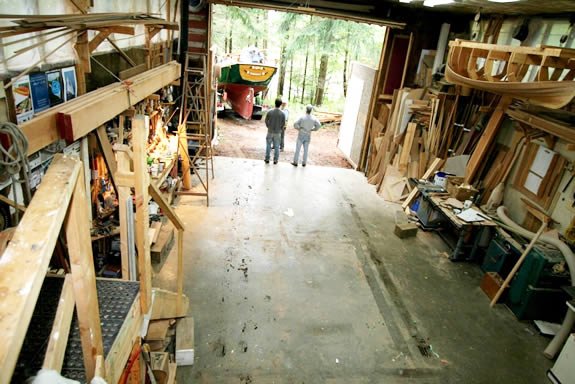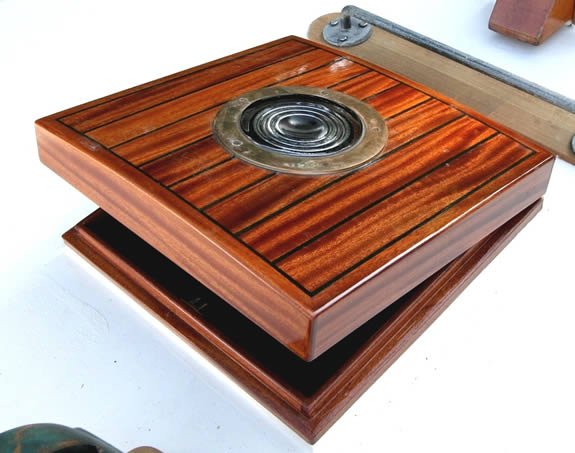
2005 job was to make a folding back of settee to convert seat to double berth instead of just a single
Building the ice box in the shop
The owner enjoys using the boat every chance he can get and is very interested in keeping it in good shape. He phoned me up with some concerns and asked me to have a look at the stern taffrail and figure out what was wrong with it. I could immediately see that a previous owner had painted over the original varnish to mask any problems. The trouble was that the rail was coming apart mostly because it was made of oak and held together with iron ready rod and galvanized screws, and the iron had started rusting, in turn, it was reacting with the tannins in the oak causing an acceleration of iron sickness.
The diagnosis was to repair the rail by removed it and rebuilding. Unfortunately this ended up being the least of his problems; as I was turning to disembark the boat, I noticed when stepping on an area just behind the steering inspection hatch on the aft deck, there was a real spring to it. The deck and house were completely covered with polyester resin and fibreglass, with little ventilation in the aft of the boat, the plywood under the fibreglass was rotting away. After telling the owner of the new found problem, we met at the boat and with a hammer tapped the entire deck, mapping out all the other hollow sounding areas. Because we couldn’t get into the aft area of the boat to see the extent of the damage, I pointed a camera with a flash through the small hatch to take a picture to help show us the extent of the damage.
The problem was obvious, no good ventilation and inferior plywood was used for decking. My assumption being because this boat was built in the 70’s, a cheap non-marine plywood was used thinking the fibreglass would protect it.
We talked about options for repairing, and because the problem areas were not just located in the aft of the boat, the proper job was to pull of the deck and replace it. The owner enjoys using the boat and also wants to maintain its value; his decision was to do the right thing and replace the deck as long as he could work with me on the repairs, as well he requested to bring her to a level that would look good at the local wooden boat shows.
Since these discoveries, the boat has been pulled out of the water and trucked to my shop with all the work up till now being removing the deck.
The carved squids to finish off the ends of the taff rail
Cliff and Jody are getting ready for the evening shift, sanding and varnishing all the woodwork on deck
Finished new taff and squid
Willow exited with all the commotion on launch day
Getting ready to head out and test the rig
The tail end of Aja leaving the shop for the boat yard
The boat mover backing the boat into the shop
The fibreglass peeled up easily as well as showing how the plywood was delaminating because it wasn’t made with waterproof glue.
New ice box installed
The boat just fit into the shop with the deck waiting to be worked on
Tony doing the final sanding on the carvings
There is new trim that wasn’t there before all around the house. This photo also shows all the varnishing done and all the new bronze hardware before it goes green from ocean spray
Finishing the final details in the boat yard. Her new colour scheme looks very classy
New forward hatch with prism light
Cliff is happy seeing Aja go in with out any problems
Perfect weather for her maiden sail, nice way to end a fun project
The deck was removed in a few days
Web Update ~ Cliff's Boat
While the owner Cliff and I were restoring the “Kentish Maid” decks, several other changes were taking place; Cliff said if things were not done completely then he knows he would not be happy with himself in the end.
The hatches were replaced after realizing that repairing them would be more work than replacing them. New chain plates were made of Silicon Bronze as the old ones were steel and continually bleeding down the hull. The hull colour being originally white was changed to a dark green, which looks very classy on the finished boat. The taff rail around the stern deck has carved squids to tie the top of the rail to the deck on both sides. And along with many other repairs and changes, her name was changed from the “Kentish Maid” to “Aja”.
NEW DECK FOR THE "KENTISH MAID"
Cliff's Boat
I have known the owner of a 30' V-Bottom Schooner, Little Maid of Kent (designed by William Atkin) for a while now since I had done some interior renovations on his boat back in 2005. The boat is called “Kentish Maid”, with her construction being strip planked red cedar on oak frames, with polyester resin and fibreglass sheathing the hull, and was home built in the 1970’s. The boat was well built with a real touch of details that makes it an attractive boat with a real salty touch.
2005 Seat now converted to double berth
Blackened stained wood is a tell tail sign of iron sickness
After the stanchion post is removed the extent of the damage was revealed
Photo taken under the deck of inaccessible area
Getting ready to lift the boat, this also shows a good view of the Taffrail that started this process
This shows the aft deck rotten areas
The new plywood decks have 10 oz fiberglass and epoxy, finished with polyurethane, painted colour is Hetteras off white
The taff rail made of African mahogany is installed
John working on the spars
Champagne is a must with the new name and successful launch
Deck prisms were placed in the side decks and work great at lighting up an inside area that is typically very dark
New aft hatch
2005 Getting ready to cut opening for new ice box for in the galley.

































